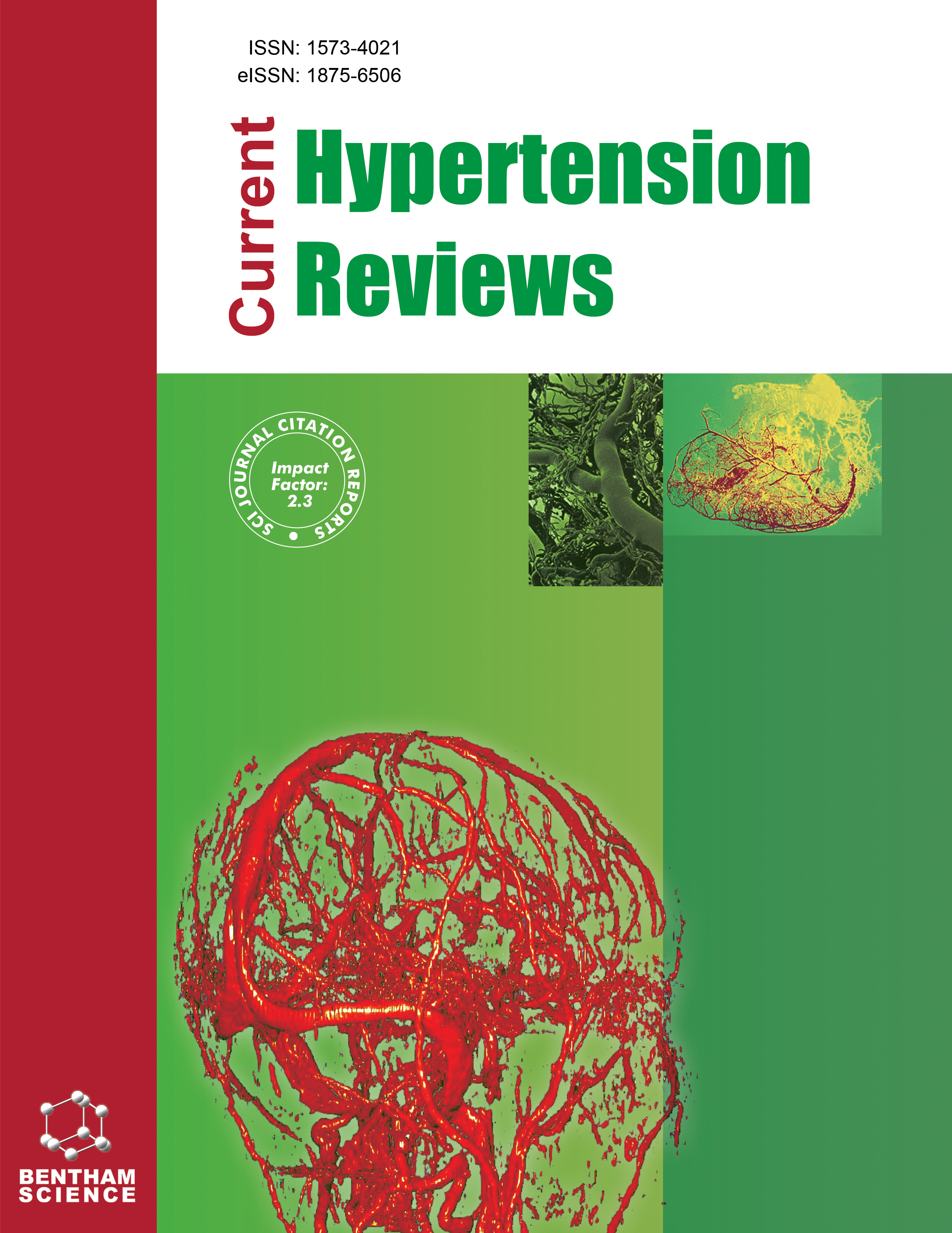- Home
- A-Z Publications
- Current Hypertension Reviews
- Previous Issues
- Volume 18, Issue 2, 2022
Current Hypertension Reviews - Volume 18, Issue 2, 2022
Volume 18, Issue 2, 2022
-
-
Hormone-Dependent Regulation of Renin and Effects on Prorenin Receptor Signaling in the Collecting Duct
More LessAuthors: Lucienne S. Lara, Alexis A. Gonzalez, Matthew T. Hennrikus and Minolfa C. PrietoThe production of renin by the principal cells of the collecting duct has widened our understanding of the regulation of intrarenal angiotensin II (Ang II) generation and blood pressure. In the collecting duct, Ang II increases the synthesis and secretion of renin by mechanisms involving the activation of Ang II type 1 receptor (AT1R) via stimulation of the PKCα, Ca2+, and cAMP/PKA/CREB pathways. Additionally, paracrine me Read More
-
-
-
(Pro)renin Receptor and Blood Pressure Regulation: A Focus on the Central Nervous System
More LessAuthors: Lucas A.C. Souza and Yumei F. EarleyThe renin-angiotensin system (RAS) is classically described as a hormonal system in which angiotensin II (Ang II) is one of the main active peptides. The action of circulating Ang II on its cognate Ang II type-1 receptor (AT1R) in circumventricular organs has important roles in regulating the autonomic nervous system, blood pressure (BP) and body fluid homeostasis, and has more recently been implicated in cardiovascular m Read More
-
-
-
The Role of (Pro)Renin Receptor in the Metabolic Syndrome
More LessAuthors: Kellea Nichols and Frederique YiannikourisThe prorenin receptor (PRR) is a complex multi-functional single transmembrane protein receptor that is ubiquitously expressed in organs and tissues throughout the body. PRR is involved in different cellular mechanisms that comprise the generation of Angiotensin II, the activation of Wnt/β-catenin signaling, the stimulation of ERK 1/2 pathway, and the proper functioning of the vacuolar H+-ATPase. Evidence supports the role Read More
-
-
-
Treatment with Cannabidiol Results in an Antioxidant and Cardioprotective Effect in Several Pathophysiologies
More LessCannabis sativa has chemically active compounds called cannabinoids, where Δ9- tetrahydrocannabinol (THC) and Cannabidiol (CBD) are the major ones responsible for the various pharmacological effects. The endocannabinoid system is an endogenous system considered a unique and widespread homeostatic physiological regulator. It is made up of type 1 (CB1) and type 2 (CB2) cannabinoid receptors. CBD, in turn, has Read More
-
-
-
Unravelling the Mechanistic Role of ACE2 and TMPRSS2 in Hypertension: A Risk Factor for COVID-19
More LessAuthors: Nalini Govender, Olive Khaliq, Jagidesa Moodley and Thajasvarie NaickerBackground: This review explores the mechanistic action of angiotensin-converting enzyme- 2 (ACE2) and transmembrane protease serine 2 (TMPRSS2) in the renin-angiotensinaldosterone system (RAAS) that predisposes hypertensive patients to the adverse outcome of severe COVID-19. Methods and Results: Entry of SARS-CoV-2 into the host cell via ACE2 disrupts the RAAS system, creating an imbalance between ACE and Read More
-
-
-
Target Blood Pressure and Combination Therapy: Focus on Angiotensin Receptor Blockers Combination with Either Calcium Channel Blockers or Beta Blockers
More LessAuthors: Selvia M. Farag, Hoda M. Rabea, Mohamed E. Abdelrahim and Hesham B. MahmoudBackground: The target blood pressure has changed many times in the guidelines in past years. However, there is always a question; is it good to lower blood pressure below 120/80 or not? Control of blood pressure in hypertension is very important in reducing hypertension-modified organ damage. So, the guidelines recommend combining more than one antihypertensive drug to reach the target blood pressure goal. Result Read More
-
-
-
Blood Pressure Responses in Firefighters: A Review
More LessAuthors: Carly McMorrow and Deborah L FeairhellerBlood pressure (BP) responses are controlled by various factors and understanding how BP changes is important to occupational health. This paper presents a review of the literature that reports BP responses in the firefighter population. Hypertension is one of the main risk factors underlying the pathophysiology of cardiovascular disease (CVD), and cardiac incidents remain the leading cause of line-of-duty deaths in firefighter Read More
-
-
-
Impaired Fasting Glucose (IFG) Prevalence Among Hypolipidemic Treatment- naïve Patients with Hypertension
More LessBackground: Impaired fasting glucose (IFG) predisposes to the future development of type 2 diabetes mellitus (T2DM) and may also be associated with increased cardiovascular disease (CVD) risk. Hypertension is an established CVD risk factor. Objective: This study aimed to assess the prevalence of IFG and the associated anthropometric and metabolic disturbances in patients with hypertension. Methods: Consecutive h Read More
-
-
-
ACEi/ ARB and Deaths of COVID-19 Patients
More LessAuthors: Gulam N. Azad and Anoop KumarThe practice of angiotensin-converting enzyme inhibitors/angiotensin II receptor blockers (ACEi/ARB) in COVID-19 hypertensive patients is still an open question for clinicians to answer. The present study was conducted to find out the association between the use of ACEI/ARB and the mortality rate of COVID-19 patients. The search was conducted from December 2019 to October 2020 in PubMed to identify relevant published st Read More
-
Volumes & issues
-
Volume 20 (2024)
-
Volume 19 (2023)
-
Volume 18 (2022)
-
Volume 17 (2021)
-
Volume 16 (2020)
-
Volume 15 (2019)
-
Volume 14 (2018)
-
Volume 13 (2017)
-
Volume 12 (2016)
-
Volume 11 (2015)
-
Volume 10 (2014)
-
Volume 9 (2013)
-
Volume 8 (2012)
-
Volume 7 (2011)
-
Volume 6 (2010)
-
Volume 5 (2009)
-
Volume 4 (2008)
-
Volume 3 (2007)
-
Volume 2 (2006)
-
Volume 1 (2005)
Most Read This Month
Article
content/journals/chyr
Journal
10
5
false
en


